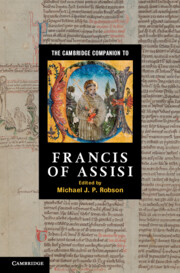Book contents
- Frontmatter
- Introduction
- PART I Francis of Assisi
- PART II The heritage of Francis of Assisi
- 10 Francis and the pursuit of learning
- 11 The early Franciscans and the towns and cities
- 12 The Third Order of Francis
- 13 Franciscan ideals and the royal family of France (1226–1328)
- 14 Franciscans as papal and royal envoys to the Tartars (1245–1255)
- 15 Franciscan missions
- 16 Pope John XXII, the Franciscan order and its Rule
- 17 The ecumenical appeal of Francis
- A guide to further reading
- Index
13 - Franciscan ideals and the royal family of France (1226–1328)
from PART II - The heritage of Francis of Assisi
Published online by Cambridge University Press: 28 November 2011
- Frontmatter
- Introduction
- PART I Francis of Assisi
- PART II The heritage of Francis of Assisi
- 10 Francis and the pursuit of learning
- 11 The early Franciscans and the towns and cities
- 12 The Third Order of Francis
- 13 Franciscan ideals and the royal family of France (1226–1328)
- 14 Franciscans as papal and royal envoys to the Tartars (1245–1255)
- 15 Franciscan missions
- 16 Pope John XXII, the Franciscan order and its Rule
- 17 The ecumenical appeal of Francis
- A guide to further reading
- Index
Summary
In 2004, the French publishing house Gallimard published Héros du Moyen Âge: le saint et le roi, a 1,318-page tome combining two recent works by Jacques Le Goff, one about Francis of Assisi and the other Louis IX of France. The subtitle is slightly misleading, since both ‘heroes’ were in fact recognised as saints after Louis's canonisation in 1297. Nevertheless, it is no surprise that Le Goff would find these two men intriguing, or that Gallimard would pair them, for they were two of the thirteenth century's emblematic figures, linked by the influence that Franciscan ideals had on Louis, his family and his Capetian descendants.
This influence is undeniable but difficult to pin down, for several reasons. First, there is the problem of defining ‘Franciscan ideals’. Francis's admirers and modern scholars have long argued over who he ‘really was’ and how his message should best be interpreted. Thus, we cannot simply ask whether the French royal court followed one predetermined model arbitrarily defined as Franciscan. Secondly, there is the problem of disentangling Franciscan piety from other related strands. The French court fostered close ties to many different orders and branches of the Church. It would therefore be disingenuous to ascribe every Capetian impulse towards piety, simplicity or humility to Franciscan influence. Searching for Franciscan influence requires close attention to actual interaction between royal figures and leading Franciscans and to structural links built up between court and order.
- Type
- Chapter
- Information
- The Cambridge Companion to Francis of Assisi , pp. 208 - 223Publisher: Cambridge University PressPrint publication year: 2011



